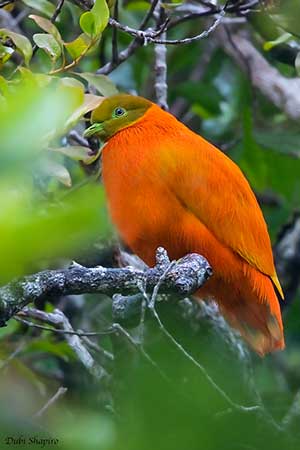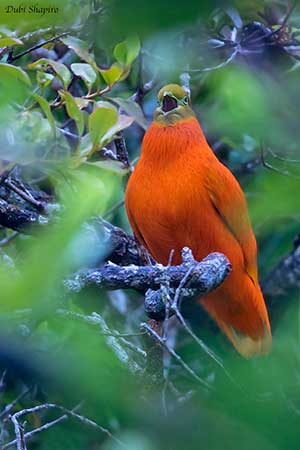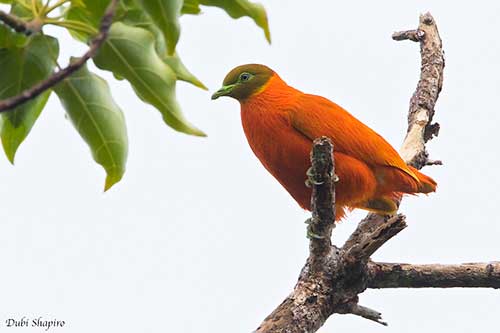
REPRODUCTION OF THIS SPECIES:
Nesting birds are recorded in June, September, November and December.
As usual in the family Columbidae, the nest is a flimsy platform made with some intertwined bare twigs. It is placed in tree, usually on horizontal fork.
The female lays a single white egg and incubates alone. From some observations, she probably tends the young alone too.
PROTECTION / THREATS / STATUS:
The Orange Fruit Dove has restricted range in which it appears to be fairly common. The population is suspected to be stable, and the species is currently evaluated as Least Concern.
Fr: Ptilope orange
Ang: Orange Fruit Dove - Orange Dove
All: Orangefruchttaube
Esp: Tilopo Naranja
Ita: Tortora arancione
Nd: Oranje Jufferduif
Sd: orange fruktduva
Photographer:
Dubi Shapiro
Dubi Shapiro Photo Galleries & Dubi Shapiro's Pictures on IBC
Text by Nicole Bouglouan
Sources:
HANDBOOK OF THE BIRDS OF THE WORLD vol 4 by Josep del Hoyo-Andrew Elliott-Jordi Sargatal - Lynx Edicions - ISBN: 8487334229
PIGEONS AND DOVES by David Gibbs, Eustace Barnes and John Cox - Pica Press Sussex - ISBN: 1873403607
Wikipedia, the free encyclopaedia
THE AVIANWEB - Beauty of Birds (Sibylle Faye)
The Guardian - Mystery bird: orange dove, Ptilinopus victor
The Beautiful Orange Fruit Dove
Orange Fruit Dove
Ptilinopus victor
Columbiformes Order – Columbidae Family
INTRODUCTION:
The Orange Fruit Dove is a small, short-tailed Columbidae. It is endemic to Fiji Islands and two subspecies share the restricted range.
It frequents a variety of wooded habitats and feeds primarily on small fruits and berries.
The Orange Fruit Dove has restricted range but it is usually common and not globally threatened.
DESCRIPTION OF THE BIRD:
Biometrics:
Length: 17-20 cm
The Orange Fruit Dove is a small, plump, short-tailed dove.
The adult male has bright orange body plumage. Neck, mantle and scapulars feathers are bright orange and elongated, with “hairy” appearance. The flight-feathers are olive-yellow with bright yellow edges. The uppertail-coverts are elongated with hairy fringes that reach the tip of the short tail.
The underparts are like the upperparts, but with less hairy feathers on belly. Undertail-coverts, thighs and tarsi feathers are bright orange. The underwing is pale yellow with orange wash on the leading edge.
The head is dark yellowish-olive, contrasting with paler chin and throat.
Bill, legs and feet are yellowish-green. The eyes are pale yellowish, surrounded by green orbital skin.

The adult female has uniformly dark green plumage. The undertail-coverts are dark yellow and the flight-feathers are darker, mostly blackish with dark green gloss. Back, rump and uppertail-coverts are deep green. She lacks the hairy appearance of the male.
The head is pale greenish-yellow, including chin and throat.
The juvenile resembles female but it has yellow edges to feathers. The young male may have green plumage with orange spots, or bright orange plumage with green blotches.
SUBSPECIES AND RANGE:
The Orange Fruit Dove has two subspecies.
C.v. victor (described above and displayed) is found in N Fiji on Vanua Levu, Rabi, Kioa and Taveuni.
C.v. aurea occurs in NE Fiji on Qamea and Laucala, off E Taveuni.
This race is larger with brighter upperparts. The female is paler than nominate, especially on breast.
HABITAT:
The Orange Fruit Dove frequents a variety of wooded habitats such as fairly open forest, secondary growth and forest gallery, and especially more closed-canopy primary forest.
It is usually seen between 420 and 980 metres of elevation.

CALLS AND SONGS: SOUNDS BY XENO-CANTO
The Orange Fruit Dove delivers its advertising call from high perches. This call probably given by the male is a penetrating “tock” frequently repeated at a regular pace, with 1 note per 1-5 seconds. The full series often follows a short, upslurred “kwee? ... pick… pick… pick”. Both mates produce a low “weeer” with half growling, half wailing quality.
BEHAVIOUR IN THE WILD:
The Orange Fruit Dove is mainly frugivorous, although some females can be seen gleaning small invertebrates from leaves, especially caterpillars.
It feeds actively in the upper canopy, plucking small berries and fruits of less than 8 millimetres in diameter. But it also takes insects, molluscs and small arthropods.
This species can be seen alone or in pairs, only occasionally in small groups. It is not usually gregarious, including at fruiting trees.
The Orange Fruit Dove is probably resident, with only some movements according to the food resources.
The flight is fast and direct and the wingbeats produce a whirring sound.
